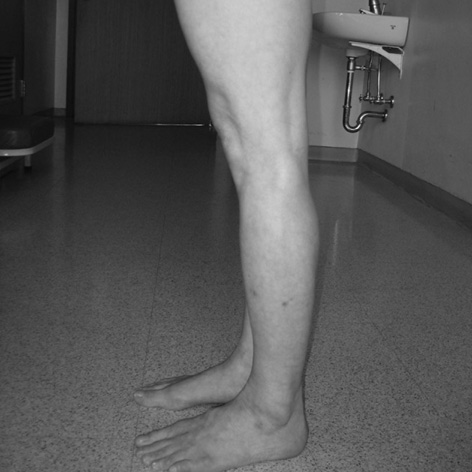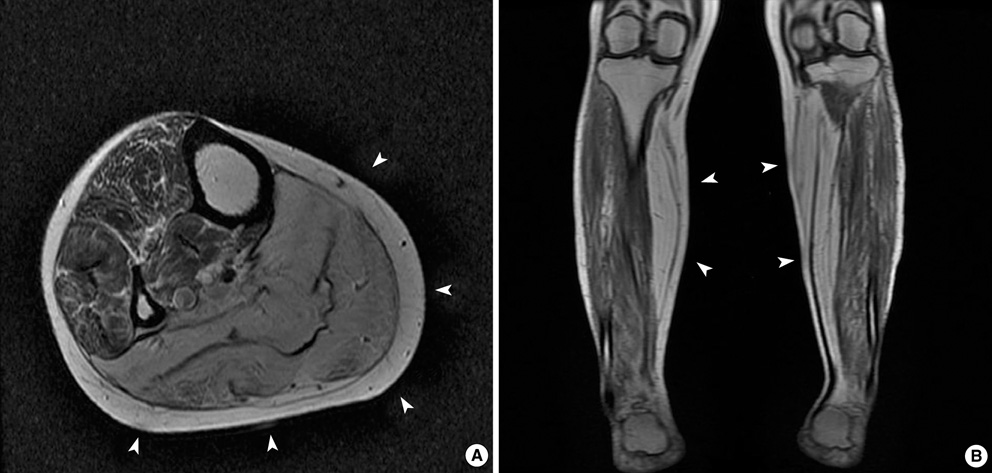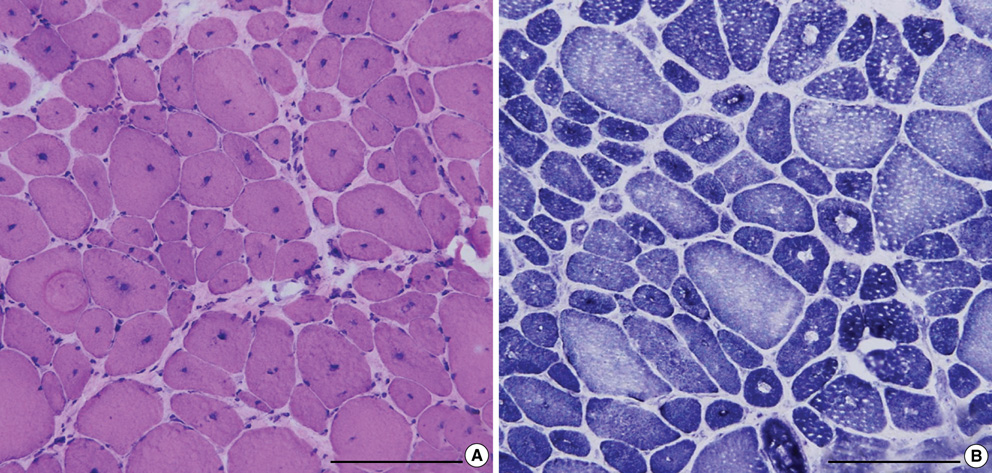J Korean Med Sci.
2007 Dec;22(6):1098-1101. 10.3346/jkms.2007.22.6.1098.
Autosomal Dominant Centronuclear Myopathy with Unique Clinical Presentations
- Affiliations
-
- 1Department of Neurology, Seoul National University College of Medicine, Seoul, Korea. pks1126@chol.com
- 2Department of Pathology, Seoul National University College of Medicine, Seoul, Korea.
- KMID: 1785779
- DOI: http://doi.org/10.3346/jkms.2007.22.6.1098
Abstract
- Centronuclear myopathies are clinically and genetically heterogenous diseases with common histological findings, namely, centrally located nuclei in muscle fibers with a predominance and hypotrophy of type 1 fibers. We describe two cases from one family with autosomal dominant centronuclear myopathy with unusual clinical features that had initially suggested distal myopathy. Clinically, the patients presented with muscle weakness and atrophy localized mainly to the posterior compartment of the distal lower extremities. Magnetic resonance imaging revealed predominant atrophy and fatty changes of bilateral gastrocnemius and soleus muscles. This report demonstrates the expanding clinical heterogeneity of autosomal dominant centronuclear myopathy.
MeSH Terms
Figure
Reference
-
1. Spiro AJ, Shy GM, Gonatas NK. Myotubular myopathy. Persistence of fetal muscle in an adolescent boy. Arch Neurol. 1966. 14:1–14.2. Heckmatt JZ, Sewry CA, Hodes D, Dubowitz V. Congenital centronuclear (myotubular) myopathy. A clinical, pathological and genetic study in eight children. Brain. 1985. 108:941–964.3. Chi JG. Myotubular myopathy: a case report. Korean J Pathol. 1986. 20:328–331.4. Hwang H, Kwon HJ, Chai JH, Kim KJ, Hwang YS. Familial myotubular myopathy occurred in a sibling. J Korean Child Neurol Soc. 2001. 9:425–429.5. Kim YH, Kwon YS, Lim DH, Jun YH, Kim SK, Hong YJ, Son BK, Han HS. A case of centronuclear myopathy. J Korean Pediatr Soc. 2002. 45:1170–1174.6. Na SJ, Kim TS, Choi YC. A case of adult-onset centronuclear myopathy. Yonsei Med J. 2004. 45:352–355.
Article7. Kim HK, Ryu WS, Hong YH, Sung JJ, Park KS, Park SH, Lee KW. A case of centronuclear myopathy. J Korean Neurol Assoc. 2006. 24:491–494.8. Mastaglia FL, Lamont PJ, Laing NG. Distal myopathies. Curr Opin Neurol. 2005. 18:504–510.
Article9. Miyoshi K, Kawai H, Iwasa M, Kusaka K, Nishino H. Autosomal recessive distal muscular dystrophy as a new type of progressive muscular dystrophy. Seventeen cases in eight families including an autopsied case. Brain. 1986. 109(Pt 1):31–54.10. Carpenter S, Karpati G. Pathology of skeletal muscle. 2001. 2nd ed. Oxford: Oxford university press;382–393.11. Wallgren-Pettersson C, Clarke A, Samson F, Fardeau M, Dubowitz V, Moser H, Grimm T, Barohn RJ, Barth PG. The myotubular myopathies: differential diagnosis of the X linked recessive, autosomal dominant, and autosomal recessive forms and present state of DNA studies. J Med Genet. 1995. 32:673–679.
Article12. Pepin B, Mikol J, Goldstein B, Haguenau M, Godlewski S. Familial form of centronuclear myopathy in the adult. Rev Neurol (Paris). 1976. 132:845–857.13. Lovaste MG, Aldovini D, Ferrari G. Centronuclear myopathy with unusual clinical picture. Eur Neurol. 1987. 26:153–160.
Article14. McLeod JG, Baker Wde C, Lethlean AK, Shorey CD. Centronuclear myopathy with autosomal dominant inheritance. J Neurol Sci. 1972. 15:375–387.
Article15. Jeannet PY, Bassez G, Eymard B, Laforet P, Urtizberea JA, Rouche A, Guicheney P, Fardeau M, Romero NB. Clinical and histologic findings in autosomal centronuclear myopathy. Neurology. 2004. 62:1484–1490.
Article16. Felice KJ, Grunnet ML. Autosomal dominant centronuclear myopathy: report of a new family with clinical features simulating facioscapulohumeral syndrome. Muscle Nerve. 1997. 20:1194–1196.
Article17. Fischer D, Herasse M, Bitoun M, Barragan-Campos HM, Chiras J, Laforet P, Fardeau M, Eymard B, Guicheney P, Romero NB. Characterization of the muscle involvement in dynamin 2-related centronuclear myopathy. Brain. 2006. 129:1463–1469.
Article




